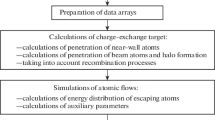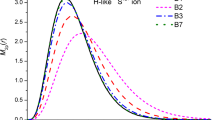Abstract
In the present work, we describe a new method, dressed cross-section model (DCSM), enabling implementation of large number of atomic transitions (~106 and more) in the kinetic simulations. The effective collision cross-sections derived from the DCSM show expected asymptotic behaviour: (i) For low plasma density, they reduce to the conventional cross-sections for single-step transitions from the ground state; (ii) the Maxwell-averaged rate coefficients are equal to the corresponding rate coefficients obtained from the Collisional-Radiative Model. We describe implementation of ionization and recombination DCSM into the PIC MC code BIT1 and present new results for tokamak plasma edge modelling.
Graphical abstract
Realistic simulations of the plasma edge require precise treatment of plasma–impurity and plasma–neutral particle interactions. Full fluid, or fluid plasma—kinetic neutral models employ effective collision rates derived from the Collisional-Radiative Models (CRM) precalculated by different atomic data providers (e.g. see Summers and O’Mullane (AIP Conf. Proc. 1344:179, 2011)). These CRM incorporate large number of atomic states (103 and more) and corresponding transitions (~106), but assume Maxwellian energy distribution functions (EDF) for colliding particles. In order to describe processes in a non-Maxwellian plasma, kinetic models are applied. Such models operate with collision cross-sections and due to limited computing power of present-day computing facilities can simulate just a few dozens of interaction channels, see Tskhakaya (Plasma Phys Contr Fusion 59:114001, 2017), Mijin et al. (Comput Phys Commun 258:107600, 2021) and references there.

The DCSM consists of two steps: calculation of averaged cross-sections for excitation collisions from the ground state and introduction of effective cross-sections based on CRM rate coefficients. The effective cross-sections derived from the DCSM show expected asymptotic behaviour: i. For low plasma density, they reduce to the direct transition cross-sections from the ground state; and ii. the Maxwell-averaged rate coefficients obtained from the DCSM are equal the corresponding CRM rate coefficients.
We demonstrate application of the DCSM in simulations of the tokamak scrape-off layer











Similar content being viewed by others
Data Availability Statement
This manuscript has associated data in a data repository. [Authors’ comment: The datasets generated in this study are available from the corresponding author, D. Tskhakaya, upon reasonable request.]
References
H.P Summers and M.G. O’Mullane, AIP Conference Proceedings, 1344, 179 (2011); ADAS: https://open.adas.ac.uk/
D. Tskhakaya, Plasma. Phys. Contr. Fusion. 59, 114001 (2017). https://doi.org/10.1088/1361-6587/aa8486
S. Mijin, A. Antonya, F. Militello, R.J. Kingham, Comput. Phys. Commun. 258, 107600 (2021). https://doi.org/10.1016/j.cpc.2020.107600
M. Surendra et al., Phys. Rev. A 41(2), 1112–1126 (1990). https://doi.org/10.1103/PhysRevA.41.1112
C.K. Birdsall, IEEE Trans. Plasma Sci. 19, 65–85 (1991). https://doi.org/10.1109/27.106800
T. Takizuka, Plasma Phys. Control. Fusion 59, 034008 (2017). https://doi.org/10.1088/1361-6587/59/3/034008
R. Panek et al., Plasma Phys. Control. Fusion 58, 014015 (2016). https://doi.org/10.1088/0741-3335/58/1/014015
P.C. Stangeby, The Plasma Boundary of Magnetic Fusion Devices, ed S Laurenson, Bristol: IOP Publishing (2000).
S. Gao et al., AIP Adv. 11, 025233 (2021). https://doi.org/10.1063/5.0037381
L. Popova et al., Contrib. Plasma Phys. 44(1–3), 252–255 (2004). https://doi.org/10.1002/ctpp.200410037
D. Tskhakaya et al., Contrib. Plasma Phys. 47(8–9), 563–594 (2007). https://doi.org/10.1002/ctpp.200710072
D. Tskhakaya et al., J. Nucl. Materials 415, S860–S864 (2011). https://doi.org/10.1016/j.jnucmat.2010.10.090
D. Tskhakaya et al., Nucl. Mater. Energy 26, 100893 (2021). https://doi.org/10.1016/j.nme.2020.100893
R.K. Janev (ed.), Atomic and Molecular Processes in the Fusion Edge Plasmas (Plenum Press, New York and London, 1995)
D. Tskhakaya et al., Contr. Plasma Phys. 56(6–8), 698–704 (2016). https://doi.org/10.1002/ctpp.201611004
Acknowledgements
This work has been carried out within the framework of the EUROfusion Consortium, funded by the European Union via the Euratom Research and Training Programme (Grant Agreement No. 101052200—EUROfusion). Views and opinions expressed are, however, those of the author(s) only and do not necessarily reflect those of the European Union or the European Commission. Neither the European Union nor the European Commission can be held responsible for them. This work has been supported by MYES project CZ.02.1.01/0.0/0.0/16 013/0001551 and Czech Science Foundation project GA20-28161S. PIC simulations were performed on Marconi and IFERC supercomputers.
Author information
Authors and Affiliations
Contributions
DT introduced the new collision operator, implemented it into the BIT1 code, performed kinetic simulations, analysed obtained results and wrote the manuscript.
Corresponding author
Ethics declarations
Conflict of interest
The author has no relevant financial or non-financial interests to disclose.
Additional information
T.I.: Atomic and Molecular Data and Their Applications: ICAMDATA 2022.
Guest editors: Annarita Laricchiuta, Iouli E. Gordon, Christian Hill, Gianpiero Colonna, Sylwia Ptasinska.
Rights and permissions
Springer Nature or its licensor (e.g. a society or other partner) holds exclusive rights to this article under a publishing agreement with the author(s) or other rightsholder(s); author self-archiving of the accepted manuscript version of this article is solely governed by the terms of such publishing agreement and applicable law.
About this article
Cite this article
Tskhakaya, D. Implementation of dressed cross-section model into the BIT1 code. Eur. Phys. J. D 77, 135 (2023). https://doi.org/10.1140/epjd/s10053-023-00682-w
Received:
Accepted:
Published:
DOI: https://doi.org/10.1140/epjd/s10053-023-00682-w




